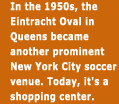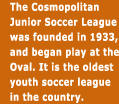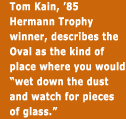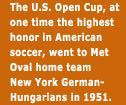|
|
 |
|
| |
The
Metropolitan Oval is a soccer field in Maspeth, Queens.
If you’re at the Oval on an average weekend, here’s what you’ll
see: Kids everywhere, playing the world’s most popular game on a surprising
patch of green wedged between row houses on one side and railroad tracks on the
other. They come from all over New York City, and from families who have come
from all over the world.
If you’d come to the Metropolitan Oval on an average weekend in the 1950s,
here’s what you would have seen: Some of the best soccer played anywhere
in America. You would have seen players of German and Hungarian heritage taking
on Englishmen, you would have seen Italians against Brazilians. You’d have
watched national championship teams; you’d have seen professionals, Olympians,
World Cup veterans. And you might have seen four or five thousand other people—people
from all over the world, who spoke different languages, ate different foods, sang
different songs—there to see a game.
The Metropolitan Oval,  now—and for the last eighty years—has been an oasis in a fast-paced,
sometimes alienating city, a place where the common bond soccer stands above cultural
differences. It is, and always has been, a place to play.
now—and for the last eighty years—has been an oasis in a fast-paced,
sometimes alienating city, a place where the common bond soccer stands above cultural
differences. It is, and always has been, a place to play.
But it was almost a shopping center.  And therein lies our tale.
And therein lies our tale.
|
|
|
| |
In 1997, Jim Vogt—a former German-Hungarian player who went on to become
president of New York’s storied Cosmopolitan Soccer League—learned that
the field was in trouble. The German-Hungarian Soccer Club, which founded the
Oval in the early 1920’s and still owned 44% of the field, had let it slip
into serious debt. The most heritage-filled pitch in the United States  owed a quarter of a million dollars in back taxes.
owed a quarter of a million dollars in back taxes.
Still, there was good news: a $1.5 million buy offer on the table. The bad news:
The developer was more interested in building a place to shop than in preserving
a place to play.
Now you should know that Jim Vogt was a defender on the pitch. And though his
playing days are behind him, soccer remains one of the most important things in
his life. So he decided to defend a piece of American soccer history.
But by 1997, the Oval seemed well past its prime. Gone were the best teams in
the land: Top players could still trace roots to the place, but they wouldn’t
risk their expensive joints on the Oval’s uneven surface. It was a mud hole
in the rainy season and a dustbowl the rest of the year. The ground sloped into
one corner, and water pooled there; savvy left backs let visiting wingers dribble
themselves into the quagmire and try to find a way out. It hosted too many games
and too many players—up to 500 matches and 2,000 players a year—and
it hosted little to no grass. 
And yet it was sacred land for American soccer. The Met Oval had been purchased
in the early 1920s by German and Hungarian immigrants who yearned for a symbol
of both old and new: a place to be who they had always been, and a place where
they could stake a claim to a new beginning. It spent the middle part of the twentieth
century at the heart of American soccer. Its home teams repeatedly won the U.S.
Open Cup,  and in the late ’60s and early ’70s, the Cosmopolitan League’s
Oval-based stars were instrumental in forming the Cosmos, who would become one
of the world’s premier clubs.
and in the late ’60s and early ’70s, the Cosmopolitan League’s
Oval-based stars were instrumental in forming the Cosmos, who would become one
of the world’s premier clubs.
Then came hard times. The best players sought better fields and the best teams
joined bigger and better leagues. The field got new life in the ‘90s, as
new immigrants—from Central and South America especially—formed local
teams that made the Oval their place to play. But neither they, nor anyone else,
were paying the field’s taxes.
What the Metropolitan Oval needed was a new beginning. And thanks to Jim Vogt,
that’s what it got.
Jim called Chuck Jacobs, whom he’d met through the Cosmopolitan League. Chuck
and his wife, Val, have deep ties in the New York soccer community—and both
are attorneys. Jim told Chuck that New York was about to lose the Metropolitan
Oval. Chuck said: “Over our dead bodies.” The defense was on.
First, the trio found everyone who owned a share in the field, mostly ancestors
of the group who founded the Oval in the ‘20s. Then they talked all of those
people into handing their shares over—just handing them over. Jim admits
this took some doing, “but I reminded them of the passion that those people
had felt for the game…”
Amazingly, Jim got the shares. All of them.
Now Jim and his partners in the fledgling Metropolitan Oval Foundation owned 100%
of a rapidly growing $250,000 debt. So Vogt went to the U.S. Soccer Foundation.
Here, he had an in: U.S. Soccer’s General Secretary, Hank Steinbrecher, had
played at the Oval in his youth. Jim’s persistence led to a $250,000 grant.
Suddenly, Jim Vogt’s dream of a twenty-first century Met Oval seemed within
reach. He envisioned a place where boys and girls with a passion for soccer could
come for coaching, tutoring, and learning, paying for the privilege by committing
time to the field’s upkeep. It would be a field where everyone, including
overlooked inner-city youth, could play. “Bottom line,” he says, “I’m
a dreamer.” Fulfilling that dream was going to take time and resources—more
that U.S. Soccer’s generous grant could buy.
Enter Nike.
Nike matched U.S. Soccer’s $250,000. A new FieldTurf  pitch was installed—a surface that’s designed to provide a high level
of green playability and a low level of maintenance for up to a quarter century.
New metal bleachers replaced the old, crumbling stands. The place was cleaned
up. And the Metropolitan Oval was reborn to fulfill its century-old destiny: Soccer’s
New York home, and an inspiration to a nation still learning what devotion to
this international religion can truly mean.
pitch was installed—a surface that’s designed to provide a high level
of green playability and a low level of maintenance for up to a quarter century.
New metal bleachers replaced the old, crumbling stands. The place was cleaned
up. And the Metropolitan Oval was reborn to fulfill its century-old destiny: Soccer’s
New York home, and an inspiration to a nation still learning what devotion to
this international religion can truly mean.
Now the city’s top teams—youth, amateur, college, pro—again clamor
for time on the transformed pitch. They are coached by players like Mike Windischmann,
who captained the U.S. in the 1990 World Cup—and Joseph Miso, an African
immigrant who calls the Oval “his life”—how he defines himself
as an American. Boys and girls from Jamaica and Puerto Rico scrimmage against
opponents with Mexican or Italian ancestry. And the Metropolitan Oval Foundation
watches over the field—and its finances—preserving the history of a
defining center of sport.
Next time you’re in New York, make the drive out to Queens. You won’t
see the sacrifices of immigrants who built a home for their sporting passion nearly
a century ago, or the dedication of a remarkable trio who rallied to save the
Oval seventy years later. But here’s what you will see: a beautiful patch
of green, and some great soccer.
And you’ll see something else, perhaps the one thing that matters most. You’ll
see the spirit of play.

|
|






